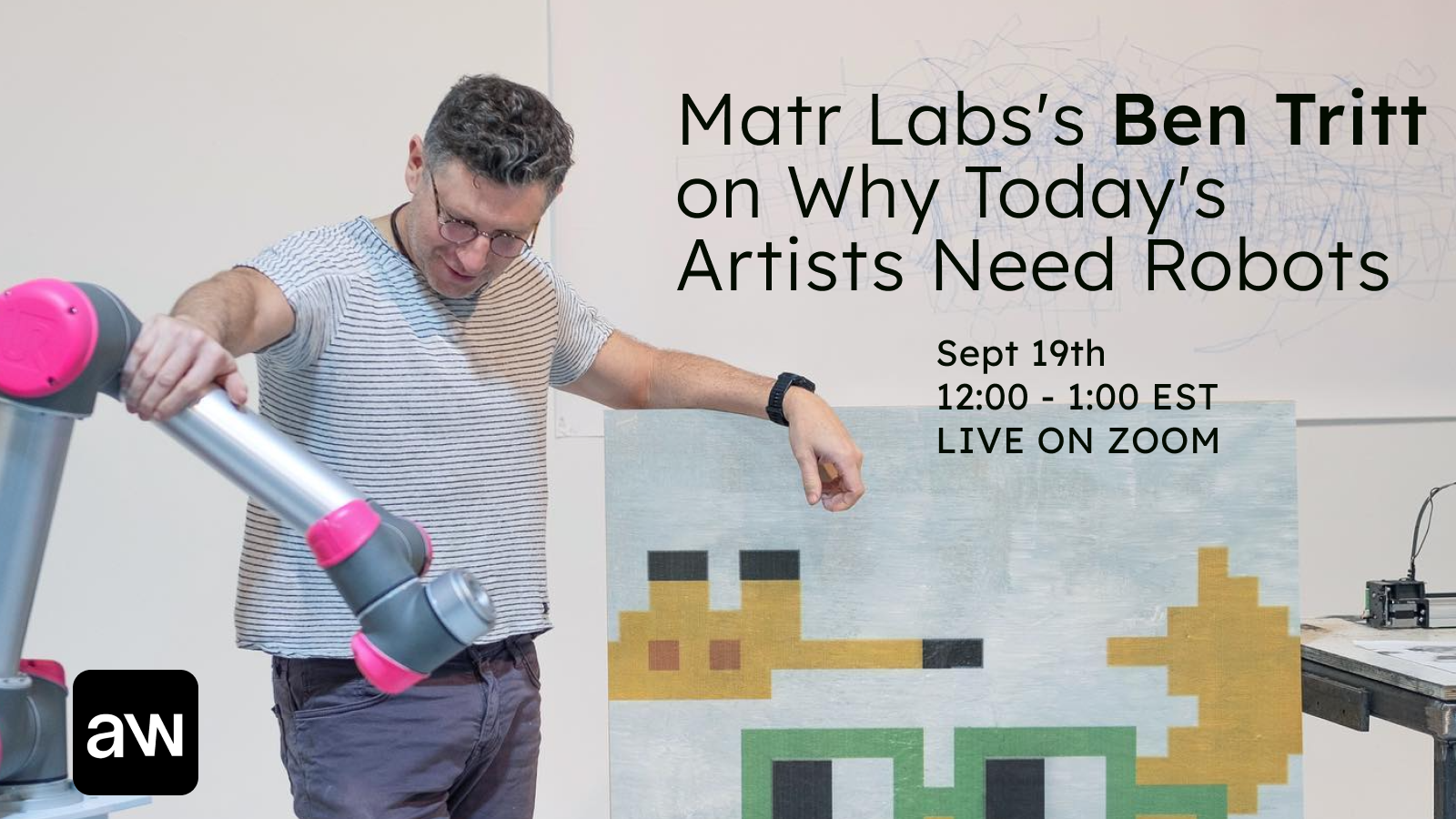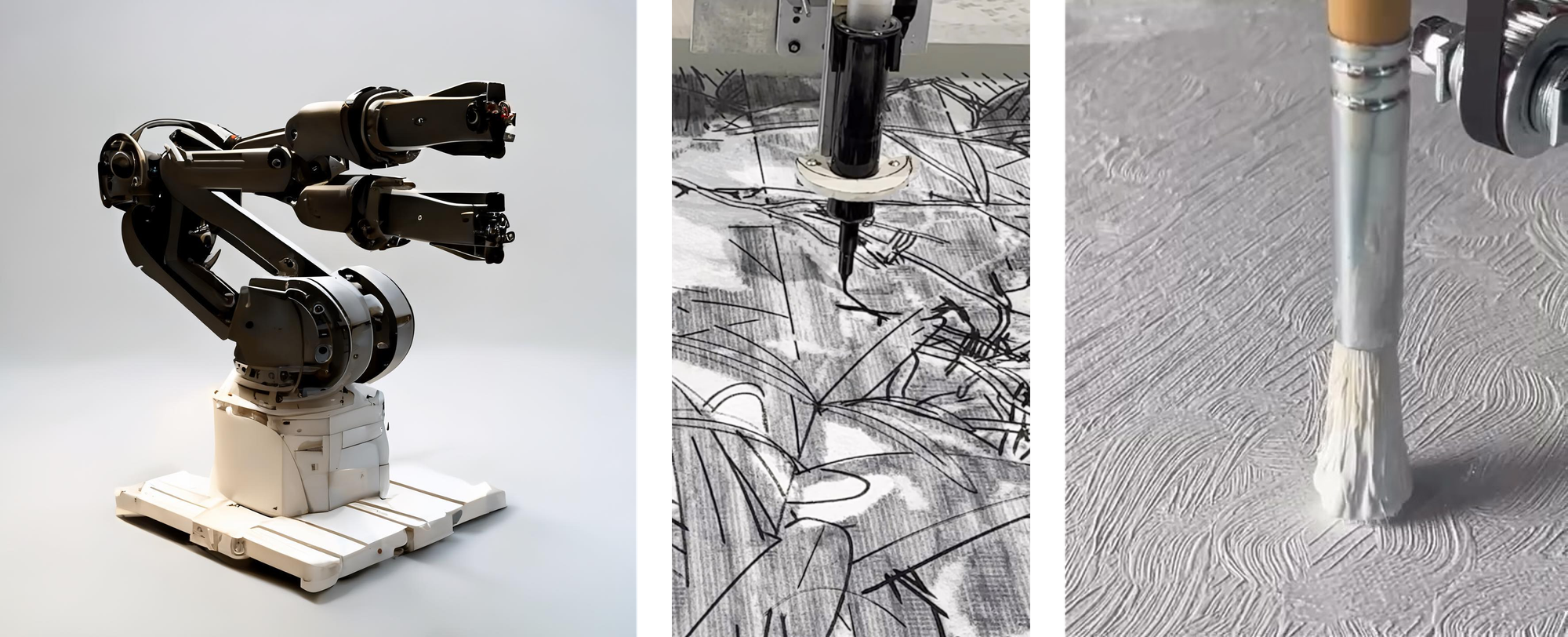Matr Labs's Ben Tritt on Why Today's Artists Need Robots, This Thursday, Live on Zoom

Artwrld editor-at-large Andrew Goldstein will be hosting a live conversation with the Matr Labs founder on Zoom this Thursday, September 19th, at 12:00 PM EST.
RSVP to join the discussion and take part in the community Q&A at the end—this newsletter is meant to help you get up to speed ahead of the talk.
In this week's email
- Meet Matr Labs Founder Ben Tritt: He's building an army of robot artists
- Pre-Read: What to know before tuning into the talk
- Community Box: We have a sign of life!
- Podcast Drop: Hear last week's conversation with Auriea Harvey
Meet Matr Labs Founder Ben Tritt
Will the artists of the future be cyborgs? Actually, some artists already are—only instead of having AI implants in their brains and robotic arms by their sides, they run AI copilots on their laptops and give orders to state-of-the-art painting machines in a laboratory in Tuxedo Park, New York.
That lab—based in a sleepy village that was once a clandestine meeting place for Einstein, Enrico Fermi, Niels Bohr, and other scientists during World War II—is the sci-fi brainchild of Ben Tritt, a classically trained painter who for years taught students how to painstakingly copy the Old Masters until he realized that technology could offer a better way. Oil painting is a 500-year-old technology, he reasoned. It was time for a systems update.

Having founded his company under the original name Artmatr Inc. at MIT in 2017, Tritt has since programmed his robots to make persuasive, impasto-rich paintings for artists ranging from Eric Fischl and Chuck Close to NFT stars like Tyler Hobbs, Beeple, and Erick Calderon to AI innovators like Anicka Yi and Alexander Reben. Now he's setting his sights on radically expanding his operation, using it to enable a new generation of digitally empowered artists to realize their virtual creations in the physical world.
What does this mean for painting as we know it? And how can we ensure that technology remains a tool for artists, instead of artists becoming a tool for technology?
This week, for our third Artwrld conversation, we are excited to sit down with Ben Tritt to talk about his vision for Matr Labs, and what he thinks the art world will look like in 2030. (Hint: very different.)
Pre-Read
NOT PRINTING BUT "MATTERING": This article by Min Chen tells the story of the company at a previous time in its history, when it was still called Artmatr and was run by an Israeli CEO and group of investors that Tritt had brought in during the NFT boom; then the bust happened, then the terrorist attack of October 7th forced the CEO to return to Israel to serve in his military unit, and Tritt bought back his company, renaming it Matr Labs. [Artnet News, 1,161 words]
BREAKTHROUGH WITH BARNABY FURNAS: All the way back in 2018, when Tritt was still at MIT, he used his technology to help the artist Barnaby Furnas (his onetime SVA roommate) create paintings for his "Frontier Ballads" show at Marianne Boesky Gallery—a body of work that looks incredible today. [Hyperallergic, 1,154 words]
FROM AI TO CANVAS: For her recent show during Berlin Art Week, artist Gretchen Andrews took photographs of five influencers, sent them to Matr Labs to realize as oil paintings, and then had another robot use a paintbrush to tweak the original images based on the recommendations of beauty-optimizing algorithms. [Forbes, 866 words]
MAKING NFTS PHYSICAL: This is a rather covetable Chromie Squiggle "reproduction" that Matr Labs worked on with the famed NFT artist Snowfro (aka Art Blocks founder Erick Calderon) alongside a far-flung consortium composed of New York's AOTM Gallery, Kansas's The Museum of Art + Light, and Iconic Moments in Chattanooga, Tennessee. [Iconic Moments, website]
WATCH HOW IT WORKS: In this charming video, Tritt and a colleague do a virtual presentation for the Hack Club, a global network of tech-loving high schoolers, where they walk through both the code and robotics used to render their paintings. It's long, so best for dipping in and out to get a peek under the hood. [YouTube, one hour and 16 minutes]
Community Box
Eureka! We have our first sign of life in the Community Box—an excellent contribution from the Brooklyn-based painter and digital artist Johanna Robinson.
Johanna writes:
- I'd like to take this opportunity to self-promote my own technologically entangled artwork, which attempts to initiate wealth redistribution in the artworld through turning paintings of wishing wells into digital coins.
- A writer/technologist I would recommend: Yuk Hui, On the Existence of Digital Objects
- I am interested in ways Artwrld could help bridge the gap between traditional art communities, including those centered around galleries and museums, into the web3 space.
Ed.'s note: that is exactly what we are trying to do, albeit with an expanded-field definition of web3 that incorporates AI, video games, mixed reality, robotics, etc.
- I'm new to reading your emails so I don't have any feedback about the Community Box being a bad idea—seems like a good idea to me! You could try it as a submission form rather than composing an email, for minimum effort, maximum response.
Ed.'s note: that is a great suggestion—we're going to work on that!
Thank you, Johanna! This is exactly the kind of community posting we are trying to platform here, so more contributions like this, please! Again, some prompts might be:
- A photo of, or link to, a technologically entangled artwork you recently saw (or made) and think is notable.
- A recommendation for someone or something Artwrld members should know about
- An idea for how Artwrld could help you better navigate the art and tech intersection.
If you have something to share, please email it to community@artwrld.com. (Submission form TK.)
Podcast Drop
Missed last week's Artwrld conversation? Here's the podcast version below—and here's a link to last week's newsletter if you want the supplementary materials too.

About Artwrld
Artwrld hosts live talks every week with leading artists, technologists, art professionals, and entrepreneurs about the opportunities and challenges at the vanguard of creativity.
more at: artwrld.com

